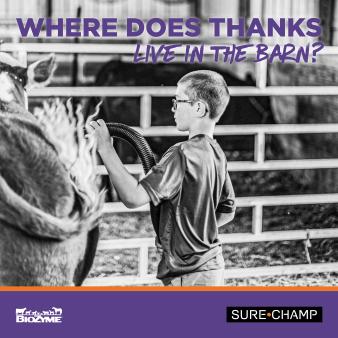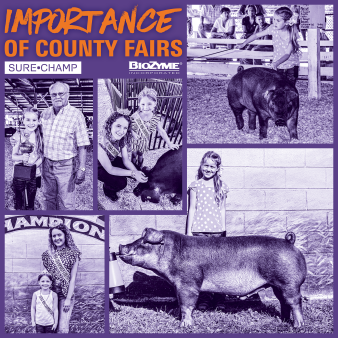
Heart pounding. Adrenaline rushing. The uncertainty of what a new judge will look for when you lead your show goat into the ring. You go through the motions; set the feet and your wether braces perfectly.
The judge is placing the class from the bottom. You are still in the hunt. You made the top four. Now three. You’re either second or first. Wait. . .You just won the biggest showmanship class of the day! The widest smile spreads across your face as you lean down and pat that cinnamon-headed goat on the top of his head in appreciation. You hear your mom cheer from the side of the show ring, “Yessss,” as the judge shakes your hand.
Showing goats is a team sport—and you didn’t win that banner on your own. Not only does it take a team of goats and the exhibitor in the show ring to succeed, but it also takes a team of people in the background.
Showing goats is one of the hottest new trends in the livestock show industry. And when we say new, let us clarify that by saying showing Boer goats—or meat-type goats—in the U.S. has only been happening for less than 30 years.
Boer goats, known for their meaty appearance, white bodies, and red necks and heads, were first introduced to the U.S. in 1993. That same year, the American Boer Goat Association was formed. Soon after, the breeders of these loveable animals started exhibiting them locally and nationwide.
Sure Champ® Can Help
At Sure Champ, our goal is to help exhibitors prep to win with their livestock projects. We even dabble in showing goats ourselves, so we know how fun and rewarding this project can be. That’s why we have created this comprehensive guide to help you with your project.
We understand the hours of time and dedication required to get an animal ready. Every species is different, yet they all take time, passion, and determination. Showing goats is especially rewarding, as each one has its own personality. They each respond to the halter and the chain a little differently. However, with a little time, effort, patience, and practice, your show goat project and you will soon become best friends.
At Sure Champ, we know champions are made at home. There is a champion inside each and every exhibitor. It takes fortitude and knowledge to succeed. We hope you find this blog filled with the information you need as you #PreptoWin.
Getting Started with Goats
Before you start showing goats, you and your parents or leaders need to have established goals for what you hope to accomplish. Will you show a breeding doe or a market wether? Do you want to have a project animal for the county or state fair? Or do you want an animal to show longer? What is your budget? These are all questions to have answers to before you start “goat shopping.”
Once you know what your goals are and have a budget determined, it is time to establish a relationship with a reputable breeder. There are several well-established goat breeders who are eager to sell goats and help young people succeed.
Start building a relationship with these goat raisers so you can become aware of what to look for in a quality animal. Additionally, they will help sell you the type of animal you want to meet your goals.
Bringing your Goats Home
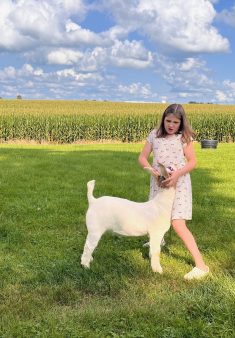
There is typically a fairly lengthy amount of time between bringing your goats home and preparing them for the first show. However, that doesn’t mean you can pen them and ignore them.
For the best success, start working with your goats when they are young. Spend the first week to two weeks getting them acclimated to their new surroundings.
It is vital to minimize the stress in their new surroundings. If they are not used to dogs in their old barn, and you have dogs, slowly introduce your dogs.
If they have been penned with other goats, consider keeping them with another goat so they don’t get lonely or bored.
Be sure your exhibitor starts working with them in their pen so the goat starts to get used to their sound, smell, and movement. Have the young person go into the pen slowly and talk to the goat. If the goat has a name, like “Poptart,” start calling the goat by its name. Or if you are calling it a number, “52,” start calling it that number so the goat learns to associate its identity. Goats are smart and will learn to come when they are called.
After a few weeks of getting in the pen, talking to the goat, and rubbing on it, it is time to start working on halter breaking and teaching your goat to lead.
Showing Goats on a Halter & Chain
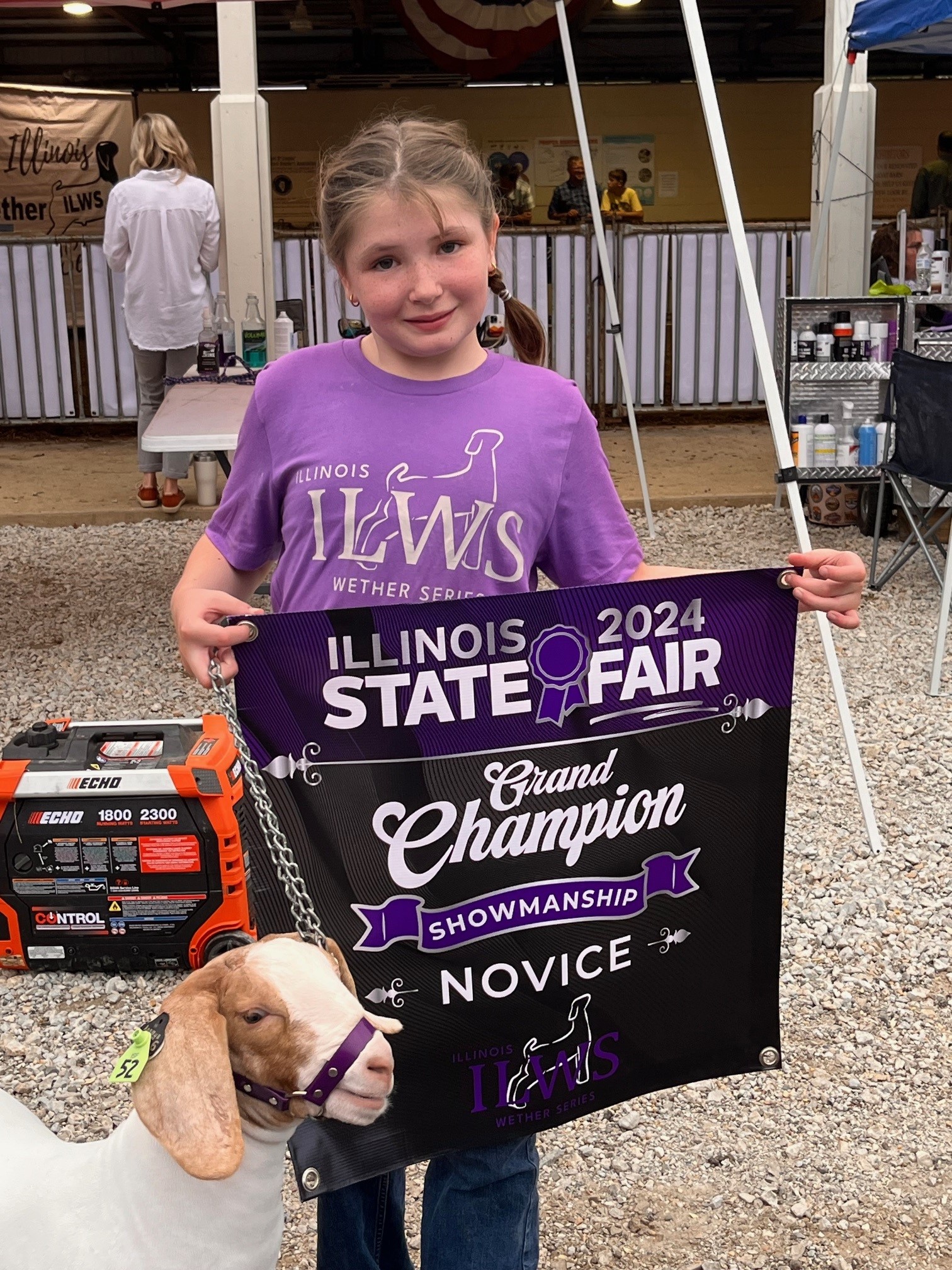
Teaching your goat to walk with a halter is important for future show ring success. It is best to get the goat acclimated to the halter early so it doesn’t balk when you lead it in the show ring.
Walk your goat with the halter daily to get it accustomed to walking with it on.
If you do have challenges getting your goat to walk, you can do a couple of things to get its attention and get it moving. First, tap your leg closest to you to get its attention and see if that helps it move.
Next, if it still doesn’t move, pull directly forward on its tail to see if it will move.
You might need someone to follow you initially to get it halter broke. Hopefully, after a short amount of time, your goat will get used to walking on the halter.
Once your goat is used to walking on the halter, switch to a show neck chain to get it used to that. Regardless of whether you choose to show on a halter or chain, it is important to lead your goat next to you to control it, with its head held high and even with its body.
Setting up Feet & Legs
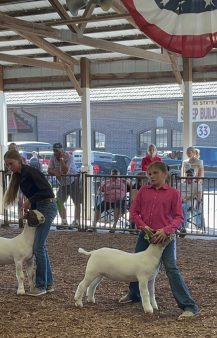
Once your goat is ready to walk and your exhibitor feels comfortable walking it in circles, it is time to start setting its feet and legs. You will want to set the goat so it looks the most eye-appealing for the judge’s body type.
This might mean setting it with the feet squarely underneath it. Or, for some goats, you might need to stretch it out to varying degrees to add extension.
Some exhibitors have the space and resources to practice in front of a large mirror. For those who don’t have this opportunity, have somebody video you so you can see how your goat looks its very best.
Likewise, you can see how you can make improvements when setting up your goat to ensure it looks its optimal best.
Most exhibitors find it simplest and most efficient to set a goat’s feet by lifting up the front end of its body by its neck and gently pushing it back on it. This will generally set its back legs where they need to be. Then, as the exhibitor lowers the front legs, they will fall into the proper position.
When it comes to ensuring your goat’s legs are set ideally, you may need to make a few small adjustments or tweaks. Use your hands to pick up the leg that needs to be moved forward or backward.
Gently pull on the chain or halter in the direction that you need the foot and leg to move. For example, if you are trying to move it forward, pull the halter or chain slightly forward to encourage the goat to move its foot forward.
Don’t Forget to Exercise

Exercise is an important component of showing goats. It helps create muscle mass for your market animals. Some people have invested in treadmills.
Be sure to know how to properly use a treadmill and follow the directions and safety protocols. Other people track goats and lambs with a working dog. Others simply run or walk their goats.
Whichever method you use, it is important that your goat exercise daily.
That being said, don’t go full boer…see what we did there? Build up the amount of time your goat exercises so they build stamina; don’t start off exercising for 20 minutes daily. Start slow and work up to a longer time period.
Working Hair & Skin
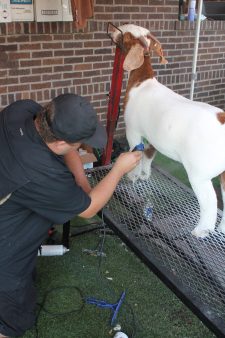
Now that you have your goat trained to show, it is important for it to look its very best. First impressions count when showing goats—or any species—and that comes with a highly presented show animal. Working hair and skin is a task that needs to be done daily.
First, you will need to wash your goat using a mild shampoo and water. Depending on the goat’s dirtiness, you might want to use a plastic scrub brush, especially on the knees. Make sure to rinse your goat thoroughly so no soap remains.
Once you have completely washed and rinsed your goat, start to blow dry it and brush it dry. This task will be easier if the goat is secured on a goat stand if you haven’t already washed it on a stand. Start blow drying from front to back and top to bottom. Avoid blowing the strong air directly into the goat’s ears and eyes, but ensure that every part of its body is completely dry.
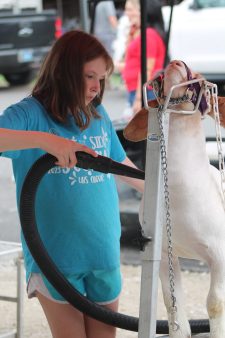
Blow and brush from front to back. Once your goat is dry, you might want to spray some skin conditioner or sheen on it. Let it set for a few minutes, brush it in, and then blow it in until your goat is dry again.
Blanket your goat to keep it clean. Washing your goat daily is unnecessary, as that will dry out its skin and hair. However, you should wash it about every third day. On the days you don’t wash it, put it on the stand, unblanket it, blow it out, and brush it with the sheen.
It all Goes Back to Nutrition
Regardless of whether you are showing good or not, quality nutrition is vital to the success of your project. Livestock feed rations should include protein, carbohydrates, fats, fiber, vitamins, and minerals. Most goat exhibitors will find a complete feed that contains most of the components they need in one feed; however, they might still find it necessary to add supplements to their goat’s diet.
Since goats are ruminants, they will require some forage to help promote digestion. It is also imperative that they have fresh, clean water throughout the day. Anytime you feed your goat, change their water. Eating and drinking work hand-in-hand, and you want your goat to have fresh water when it has fresh food.
Feed your goat about every 12 hours and maintain this schedule. If you feed it at 7 a.m., feed it again at 7 p.m., and try not to get off schedule. Gradually work your goat up to about 4 pounds of feed per day.
Prep to Win with Sure Champ
Sure Champ offers supplements for all species of show livestock. Most Sure Champ supplements contain AO-Biotics® Amaferm®, a research-proven prebiotic designed to enhance digestibility. Here are some that we suggest that you might want to keep for your
Sure Champ® Extreme with ClariFly®
Sure Champ Extreme with ClariFly is a pelleted, daily supplement for show livestock with ClariFly designed to support hoof health, hair coat, and performance when temperatures are above 70 degrees. Designed for all species, it contains Amaferm and MOS to help normalize gut microflora and support the immune system. It also contains HEAT technology, a combination of essential oils and garlic, as well as ClariFly to support animals when heat and insects are a challenge.
Sure Champ® Liquid Boost®
Sure Champ Liquid Boost is a liquid for all livestock designed to provide immediate support to the animal’s digestive and immune systems. Formerly known as Vita Charge Liquid Boost, it contains both Amaferm and MOS and flavoring to help drive the intake of feed or water.
Sure Champ® Appetite Plus Gel
Sure Champ Appetite Plus Gel is a gel for all livestock designed to provide immediate support to the animal’s digestive and immune systems. Formerly known as Vita Charge Gel, it contains both Amaferm and MOS and works fast to support appetite and hydration.
Sure Champ® Climate Control Gel
Sure Champ Climate Control Gel is a gel for all livestock designed to support digestive health and recovery when temperatures are above 70 degrees. Formerly known as Vita Charge Climate Control, this gel contains Amaferm and HEAT technology, a combination of essential oils, to support animals when heat is a challenge. It promotes appetite and water intake.
Sure Champ® Clench Gel
Sure Champ Clench Gel is a gel for all livestock designed to support normal digestive function during occasional diarrhea/scours. Formerly known as Vita Charge Clench Gel, it includes Amaferm and MOS, and it contains electrolytes to support rehydration.
Sure Champ® Joint Juice
Sure Champ Joint Juice is a liquid product for livestock designed to support joint health utilizing patented technology. Joint Juice contains MHB3®, a patented high-molecular-weight hyaluronic acid. It lubricates joints and supports mobility and soundness.
Show Day Prep
You’ve done your work at home—broken your goat to lead and set up, worked hair and skin, and exercised daily. Show day is finally here! There is a lot of excitement about finally showing goats after all the initial preparations.
Make sure you wash your goat the morning of the show. Clipping your goats the day before is best to reduce any stress on the goat. Once your goat is washed and dried, you can blanket it and let it relax.
Sure Champ has compiled a show box checklist for your packing needs. That way, you never have to guess what you need to take when showing goats.
Prior to your class, you will want to fit your goat’s legs. This can be done to varying degrees, depending on the show’s regulations and your experience levels. If the show is a “blow-and-go” or “no-fit show,” you will want to simply blow out the leg hair and brush it so it is fluffed out. If there are no specific fitting rules, you might want to fit the legs using clippers, adhesive, and white paint to make the leg bone look bigger.
Some people add baby powder to their goats and brush to give them a whiter appearance just before entering the show ring. Whatever fitting or grooming techniques you use on show day, make sure your goat looks authentic and not overstated. Judges will be able to tell the difference.
It is important for your exhibitor to look as professional as its goat. Dark blue jeans with no holes are a must. A tucked-in shirt, preferably with a collar, gives the exhibitor a clean, crisp appearance. Ball caps should not be worn, and girls’ hair should be pulled out of their faces so it is not a distraction.
The Final Word
Picture that 9-year-old girl who entered the showmanship ring at the state fair. Her heart was pounding, and her adrenaline was racing. She had the goal of showing goats, and her parents helped her make it a reality. After months of feeding, walking, washing, and practicing with her goat, she claimed the banner!
Showing goats, or any livestock for that matter, is a fun way to raise to raise kids. Young people should learn the responsibility of taking care of another being, and they should also learn the satisfaction of a job well done. Is it always easy? No. Is it always affordable? No.
However, showing goats is a fun way to introduce young people to a livestock project. Goats are easy to handle for smaller humans, typically have good dispositions, and don’t require a lot of specific tools or equipment to show. Showing goats is definitely a favorite activity among some of our team members.
Are you Prepped to Win?
Although showing goats is fun, it also takes work to get to the backdrop. Breaking goats to lead, setting feet and legs, bracing, and finding a feed routine that works for your barn are all part of making your champion at home. We hope that part of your routine will include Sure Champ products.
You can get your Sure Champ products as easily as ordering online today.
Do you prefer to support a local Sure Champ dealer? Find a dealer near you to find all your favorite Sure Champ and other BioZyme products.
Want to stay current on all of our educational blogs and news? Sign up for our newsletter.
